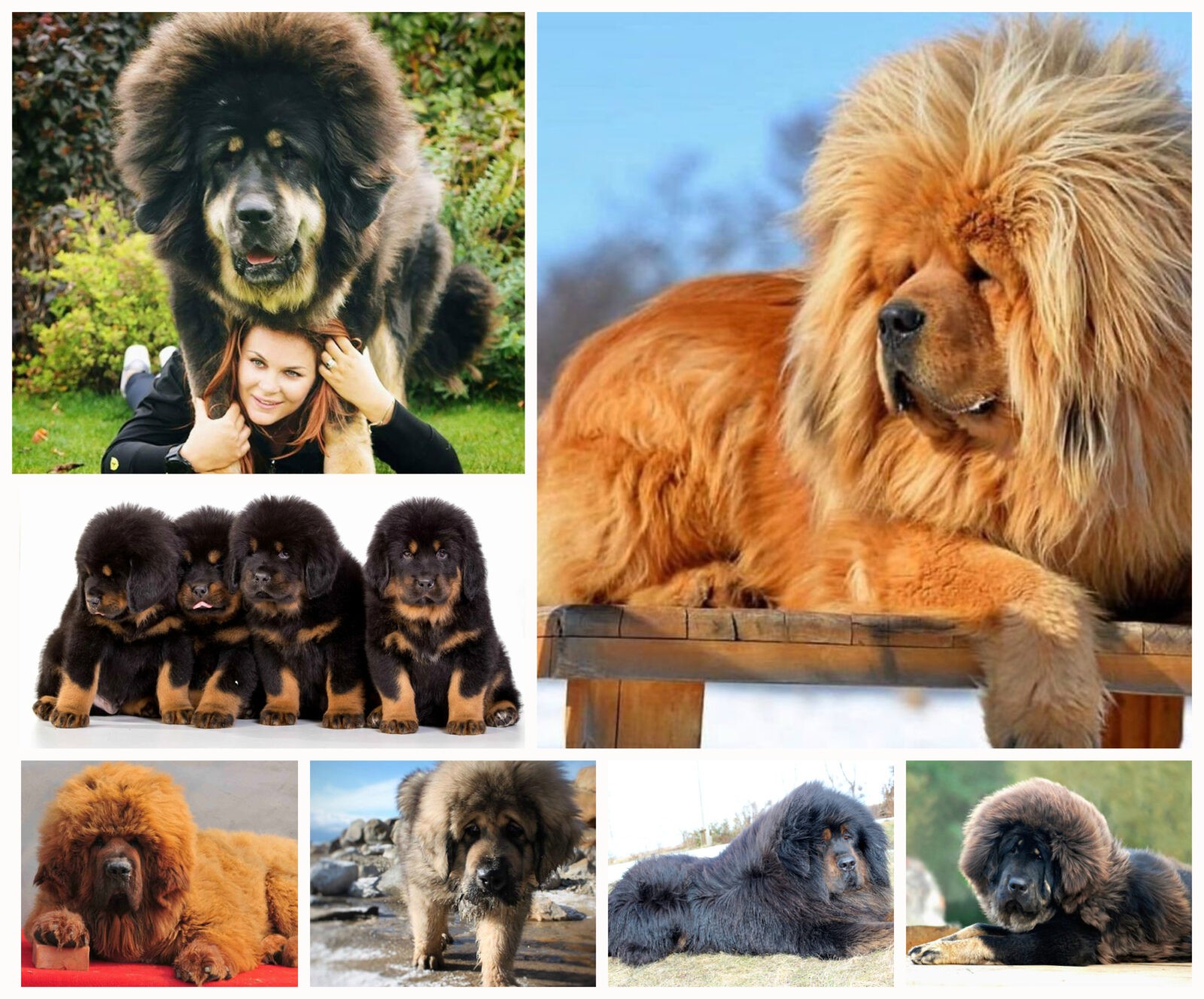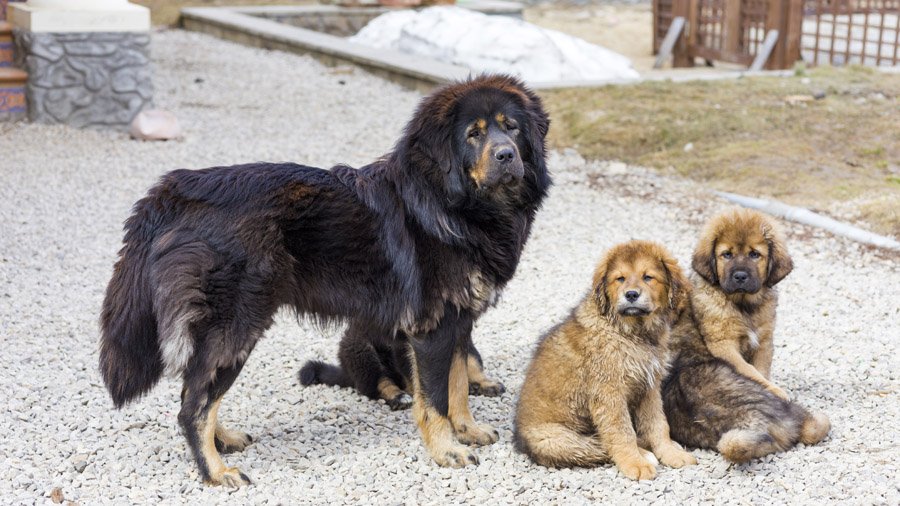Brief description of the breed
The dog has a large stature, thick hair and a fluffy tail. The Tibetan Mastiff belongs to the giant dog breeds, its weight can be from 40 to 75 kilograms. The presence of a large number of positive qualities does not mean that this breed is suitable for everyone. When purchasing a Tibetan mastiff, you must be prepared for long-term training and education.
Dogs of this breed are calm and cautious. They always stand guard over family members, even animals living in it. The dog is quite independent and decisive, it does not tolerate encroachments on its territory, quite often some Tibetan mastiffs do not even let guests into the house. Another feature of the breed is the tendency to bark at night.
Many people get a Tibetan mastiff because of its unsurpassed in protection of others. Still, this dog is not suitable for beginner dog breeders. A pet needs good training, in most cases it is best to seek help from a specialist. The Tibetan mastiff does not tolerate discord in the house, so if you have a mastiff in your family, then it is better to forget about family quarrels!
It is necessary to start training from the first day the dog appears in the house, that is, at the age when the dog is completely manageable and pliable. A twenty-kilogram lump will grow and develop very quickly. Therefore, an unprepared person cannot cope alone with education and training. This mission is best entrusted to a specialist. In education and training, standard approaches should be used: praise and gratitude.
The early period of socialization is very important. It will eliminate the possibility of distrust and aggression. It is necessary to hand over a dog for training in specialized classes immediately after the necessary vaccinations have been carried out, and, of course, when the veterinarian gives approval for this. Training in special classes for dogs will instill in the animal a sense of obedience, positive reactions to surrounding relatives and love for family and loved ones.
Adult Tibetan mastiffs are not very active, which cannot be said about puppies. Dogs of this breed are best kept in homes with their own large yard with a high fence (up to three meters in height). An underground electric fence will not become an obstacle for this large dog. Therefore, it is necessary to equip a stationary fence. You should also pay attention to the fact that walking with a Tibetan mastiff should be done exclusively on a leash, because animals of this breed are not among those pets that easily respond to the call when they are free.
Like most dogs, Tibetan Mastiff puppies - real fidgets. Due to its size, the puppy's active behavior can cause damage to the owner's property in the form of damage to furniture and interior items. To avoid such troubles, the Tibetan Mastiff must be constantly busy with something: an active game, a walk, a run around the yard, etc. Of great importance, of course, will be the early socialization of the animal. If the puppy is bored, then get ready for the "destruction" in the house.
Keeping a Tibetan Mastiff on a chain or an elementary lack of attention - this is not only a manifestation of cruelty on the part of the owner, but also utter heartlessness, which will ultimately lead to aggression and disgusting behavior of the dog. The Tibetan Mastiff can live outdoors and be alone. But the best qualities of a companion dog will appear only if the animal is in the family circle.
basic information
| Breed name: | Tibetan mastiff |
| Country of origin: | Tibet |
| The time of the birth of the breed: | 1121 BC e. |
| Type of: | Molossians |
| The weight: | 40 - 75 kg |
| Height (height at the withers): | 61 - 66 cm |
| Life Expectancy: | 10 – 14 years old |
|
ICF classification:
|
Group 2, Section 2, Number 230 |
| Puppies price: | 300 – 2200 $ |
| Most popular nicknames: | List of nicknames for the Tibetan Mastiff |
Assessment of breed characteristics
| Adaptability
(a definition meaning how easily a dog can adapt to changes in life) |
🐶🐶🐶 |
| Shedding level
(Level and frequency of hair loss in the animal) |
🐶🐶🐶🐶 |
| Tenderness level
(The level and amount of tenderness and affection that the dog gives in return for attention to itself) |
🐶🐶🐶 |
| Exercise needs
(Dog's daytime activity level) |
🐶🐶🐶 |
| Social need
(The required number of contacts of the dog with other animals, as well as people) |
🐶🐶🐶 |
| Apartment content
(A factor that determines the level of noise and other inconveniences that a dog can deliver to owners in relation to the size of the apartment to the size of the dog) |
🐶 |
| Grooming
(The number of bathing, brushing, and the number of professional grooming sessions required for the dog) |
🐶🐶🐶🐶 |
| Friendliness in an unfamiliar environment
(Features of the behavior of a dog in a society with strangers or in an unfamiliar environment) |
🐶 |
| Tendency to bark
(Tendency to bark and its frequency and volume) |
🐶🐶🐶🐶🐶 |
| Health issues
(Potential health status of the dog) |
🐶🐶 |
| Territoriality
(The dog's tendency to protect his home, yard, or even his owner's car) |
🐶🐶🐶🐶🐶 |
| Friendliness to cats
(The tendency towards tolerance for cats and decreased manifestation of hunting instincts) |
🐶🐶🐶 |
| Intelligence
(The ability of the dog to think and solve emerging difficulties (not to be confused with learning!) |
🐶🐶🐶 |
| Education and training
(The level of difficulty in training the dog to perform certain actions) |
🐶🐶🐶 |
| Friendliness to children
(A factor that determines how friendly a dog is to children, whether he likes to play with them and tolerate some childish pranks) |
🐶🐶🐶 |
| Game activity
(The concept is determined by its very name, and, as a rule, is found in almost all dogs) |
🐶🐶🐶 |
| Observation
(The ability of a dog to detect the presence of a stranger on its territory) |
🐶🐶🐶🐶🐶 |
| Friendliness to other dogs
(The tendency of the dog to find common language with his other relatives) |
🐶🐶 |
Tibetan mastiff photo:

Origin story
The nature of the Tibetan Mastiff
Maintenance and care
Training and education
Health and disease
Some interesting facts
- Be prepared for your Tibetan Mastiff puppy to grow into a huge dog. The size of this dog makes it almost impossible to live in an apartment.
- Tibetan mastiffs are usually especially active in the morning and evening. If you can't pay enough attention to the dog at the time mentioned, then this pet is definitely not right for you.
- The Tibetan Mastiff, as a rule, behaves quite calmly in the house.
- Dogs of this breed should not live on the street. As a companion dog, the Mastiff should reside in the home.
- Due to the nature of the Tibetan Mastiff, you should not walk your dog without a leash.
- Dogs This breed is very intelligent, independent and stubborn, but very sensitive to people who show love and attention.
- This dog breed is not for those people who want their pet to excel in agility and obedience.
- If you leave the Tibetan Mastiff in the yard, then most likely he will bark all night, reminding the owner that he was left alone. In the house, these dogs behave diligently.
- Tibetan mastiffs do not shed very actively. Weekly brushing will be enough to keep the coat in good condition. During molting, of course, the dog needs to be combed more often.
- Tibetan mastiffs are not suitable for timid, insecure people, as well as for beginner dog breeders. These dogs need a confident owner who can be a real leader for the animal.
- Without proper mental and physical exercise, the Tibetan Mastiff can get bored. This will lead to disobedience, barking and other negative manifestations of the dog's behavior. If you decide to get this dog, you should be prepared for the fact that you will have to devote a lot of time to the animal every day.
- As a rule, Tibetan mastiffs who have grown up with children adore them and love to play with them. But you should understand that this is a big one. animal with a special disposition. Careless behavior of a child can cause a certain aggression in a dog. That is why you should never leave a child with a Tibetan mastiff without adult supervision. The Tibetan Mastiff is not suitable for families with small children.
- If you want to become the owner of a healthy and strong dogsNever purchase puppies from random, unverified breeders or pet stores. It is best to contact well-known dog breeders.
Nurseries and breeders
We borrowed material from the wonderful site of our partners DOGCATFAN.COM about cats and dogs, the author dogcatfan

